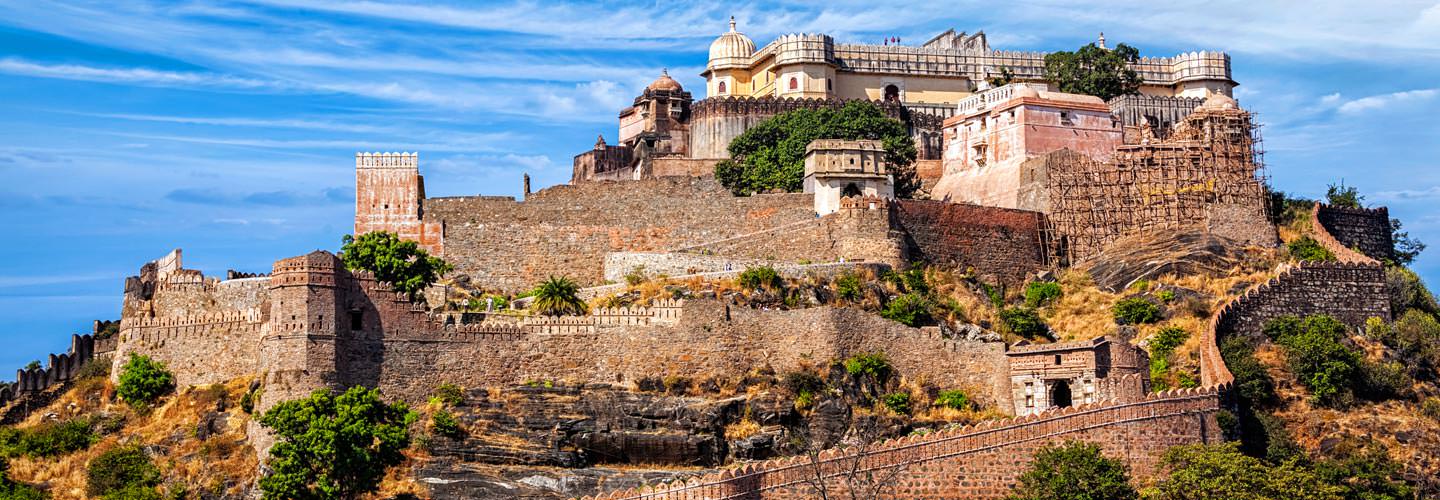
Famously known as " Kumbhalmer" Kumbhalgarh is one of the most acclaimed and famous tourist destinations in Rajasthan. A marvel in artistry, Kumbhalgarh is celebrated for being the birthplace of Maharana Pratap, one of the most influential and dynamic kings of Mewar. This widely-known tourist attraction in Rajasthan is located about 100 km away from another astounding destination called Udaipur. The city boasts intricately carved temples that represent the architecture of the ancient times.
Kumbhalgarh is particularly known for its Herculean Kumbhalgarh Fort which is one of the five forts of Rajasthan. This historical structure stands with utmost grandeur in the Rajsamand district of Rajasthan and lies close to Udaipur. Towered at an altitude of 1,100 meters, Kumbhalgarh fort constructed on the foothills of Aravalli ranges is surrounded by the thirteen hilly terrains.
Cradled on the banks of Banas River, the invincible Kumbhalgarh fort served as a refuge for the rulers of Mewar during the times of war. Strengthened by watchtowers and rounded bastions, the Kumbhalgarh fort is self-contained in all respect to withstand a protracted siege.
It took some 15 years to build this fort which was later renovated by Maharana Fateh Singh in the 19th century AD. The massive wall of the fort stretches to some 36 km with a width enough to take eight horses abreast.
Kumbhalgarh is the second largest and the most important Mewar Fort of Rajasthan, after Chittorgarh palace. This distinguished fort was built under the reigns of Mewar Kings in Rajasthan by Rana Kumbha in the 15th century.
Named after the King Kumbha, this imperial fort was cleverly designed on a hilltop to provide a strategic position to the Mewar kings to protect them against the attacks of the enemy. Considered as the most beautiful architecture of the Mewar rulers, Kumbhalgarh was referred to as “The Eye of Mewar” as it offered a bird’s eye view of the countryside for miles around.
Not many people know that the wall of Kumbhalgarh that runs through the entire fortress is considered to be the second-longest wall in the world right after the ‘Great Wall of China’. Therefore Kumbhalgarh is sometimes referred to as the ‘Great Wall of India’.
This massive 15th-century fort has around fourteen fortified gateways to enter and also houses several prolific structures in its premises.
Tucked away in the midst of the Aravalli ranges, Kumbhalgarh Fort is a marvel in architectural grandeur. This monumental fort offers a vivid panorama of the surrounding landscape along with the sand dunes of the Thar Desert.
A cluster of 360 temples encircles the fort out of which 300 are Jain temples and the rest are Hindu temples. A stroll around the compound of Kumbhalgarh fort can be very interesting and educative.
The most iconic structure of Kumbhalgarh is the Badal Mahal also known as the ‘Palace of the Clouds’ located atop the fort, offering a resplendent view of the pictorial surroundings. Lovers of art also visit this fort to admire the ruins that speak volumes about the strife.
Some of the places to visit near Kumbhalgarh Fort are the Neelkanth Mahadeo Temple, Kumbhalgarh Wildlife Sanctuary, Ranakpur Jain Temples, etc. Here you can also see the sound and light show that takes place at the Fort at 6:30 pm.
The best time to visit Kumbhalgarh city is from October to March. During this season the temperature remains moderate and provides favorable weather to visit Kumbhalgarh city. December to March is a very good time to spot animals like wolves, leopards, sloy bears and panthers.
Kumbhalgarh has a moderate climate. In summers (March to June), mercury level rises up to 43°C. Winters (November to February) are cold and the temperature goes down as low as 12°C. Monsoons (July to September) offer medium rainfalls.
Leave a Message